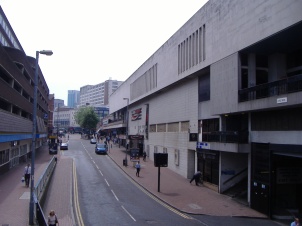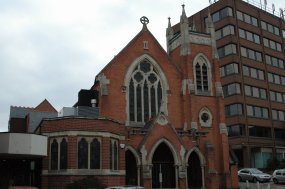 Many will know Dale End, especially the younger generations of today as it is the home of the Carling Academy, a popular haunt for many teenagers hoping to see some of today’s most popular bands. Go back 800 years and this was a popular site for the town too, who hoped to be accepted into a monumental priory dedicated to St Thomas.
Many will know Dale End, especially the younger generations of today as it is the home of the Carling Academy, a popular haunt for many teenagers hoping to see some of today’s most popular bands. Go back 800 years and this was a popular site for the town too, who hoped to be accepted into a monumental priory dedicated to St Thomas.
Dale End is deep rooted in religious history. A little known fact about the site is the St Thomas Priory that occupied it for several hundred years. It was dissolved under the Tudor reign in 1536 and the buildings were destroyed in 1547. Prosperity here rapidly declined. There was no businesses wishing to set up on site and for 150 years, the site was littered with debris from the demolished priory. Nothing is known of the architecture of the priory but as priories from long ago appear, it must have been on a grand and impressive scale with brilliant architecture which we would no longer be able to achieve often in today’s society. It takes the most ambitious and those who have a bit of money to splash to really undertake something like this – and sometimes it fails such as the Millennium Dome.
It took John Pemberton to finally do something about the site who bought it in 1700. John Pemberton developed the site around Old Square and created a residential district there. The affluence in the area took off. In the 1700s, the Barley Market moved from the Bullring area to the junction of Bull Street and Dale End. In 1763, Sampson Lloyd and John Taylor established a private banking business known as Taylors & Lloyds on the site which would develop into Lloyds Bank. Old Square quickly became the hottest place in town for the rich. The houses were villas with bay windows and were two stories in height. They sat in rows to the square
Old Square was severely affected by the construction of Corporation Street beginning in 1873. The layout was completely rearranged but with it came benefits. New, grand buildings were constructed such as the impressive Grand Theatre. The architecture of the facade of the theatre was reminiscent of the theatre buildings being constructed in Prague which have now become international icons.
The actual site of Dale End was more of a backwater to the affluence and vibrancy being witnessed in Old Square. By the Victorian times, Birmingham’s centre was split into several parishes which later became wards for the council. Each of these had a church, of which many still remain such as St Martins, St Philips, St Pauls and St Thomas’ (though it is now no longer a church and more a monument). Dale End was the location of one of the churches – St Peters. It was described as a noble edifice and not much more. Connecting Dale End to Old Square was Lower Priory which was fronted by a chemical works and many public houses and hotels. Intermingled with all this was a conglomerate of residential properties which developed into slums.
Dale End needed a miracle if it were to rekindle the prosperity of before. That miracle (though it was a tragic one at that) in the form of World War II. Before the war, the site had become a commercial location with shops establishing themselves either side. However, it still retained an air of poverty and people still ignored the site in favour of Corporation Street and the Bullring. So, in came war and the Germans bombed Dale End to an oblivion. The entire street was cleared by the bombs and it experienced some of the worst damage in the city centre.
This heavy destruction set it up for post war development and it didn’t take long. First of all came the inner ring road. This bounded the site at the east and to the north through the construction of the Priory Queensway. One of the biggest acts of architectural vandalism was witnessed in the construction of the queensway – the demolition of the Grand Theatre. Of course it was met with tears and opposition but according to the ‘great’ Manzoni, it was had to go. Following this, in came the next blow – the expiration of leases for buildings on Corporation Street. This presented developers with an opportunity to grasp their own piece of business on the street.
So with these combined factors, Dale End was itself subject to postwar development and this came in the form of Sir Frederick Gibberd. He designed a brand new shopping precinct in the city which began construction in 1964. It was completed and opened in 1966. This Brutalist monster is there today. The concrete facade is featureless with the exception of natures additions of grime and stray vegetation growing in the cracks appearing in the surface. A smell lingers over the site – not helped by the shelter over some parts and lack of air conditioning.
On the opposite side of the road came the Dale House development consisting of a 1970s redbrick multi storey car park with a highrise office structure above it. The complex also presented ground floor retail units which were snapped up by Toys R Us in more recent years.
Today the two edifices remain, and they continue to draw in a trickle of crowds though not at the scale of the early days. Toys R Us have moved from their store in the centre. This is no surprise as anyone could tell you that it was always empty and that the site was enormous. Dale House is slowly being emptied. The markets in Priory Square are slowly shutting down, mainly because of lack of business. Argos is there but deteriorating. It is a sad story.
Luckily, wonder-developers, Birmingham Alliance, have purchased the site and aim to develop it into one of the biggest developments witnessed in Birmingham since the Bull Ring (also by the same developers). Martineau Galleries is to be the second phase to Martineau Place and will feature a major mixed use conglomerate of buildings. Offices will front Corporation Street whilst a pedestrianised piazza in the centre will be the centre of the retail units. The residential units will be located above these and in a 110 metre tower which will dominate the Priory Queensway. A cultural building will front onto Moor Street.
The development will breathe much-needed life into the area and hopefully should begin construction in 2008 when the leases expire. It should be completed around 2011. What is better is that the developers acknowledge the religious history on the site through the priory and St Peter’s Church. Archaeology will play a large role in the construction of the new buildings.
So when you walk down Dale End grumbling at the site of spotty teens raving over the next big band to grace the stage at the Carling Academy, remember that this has happened for centuries and that this place has been a vibrant centre for Birmingham for centuries. The priory is reflected through names of the buildings and roads in the area but little known about so I hope you know a bit more today!

